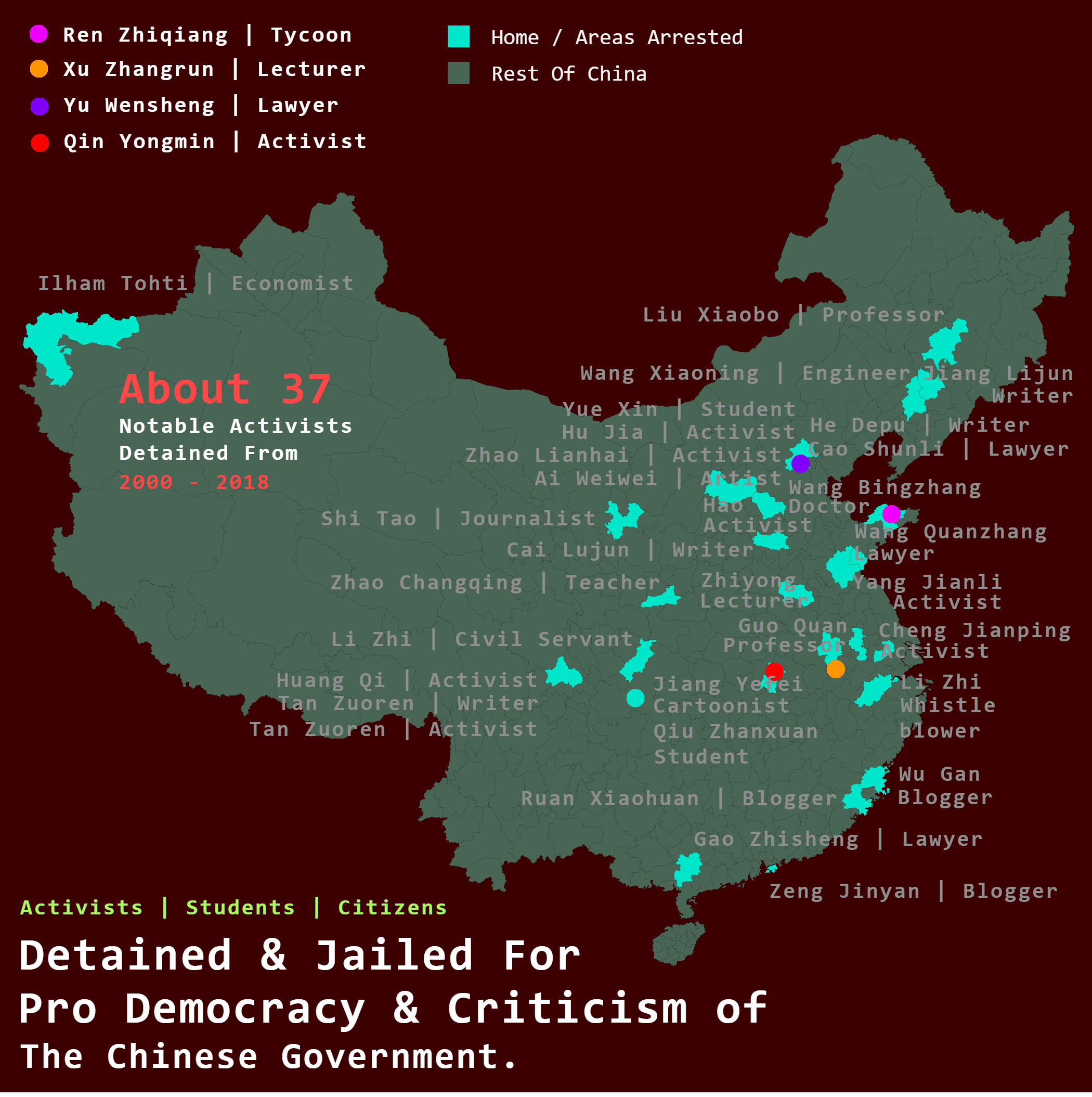

Alex Cartwright
Senior Cartographer & GIS Specialist
Alex Cartwright is a renowned cartographer and geographic information systems specialist with over 15 years of experience in spatial analysis and data...
Geographic Analysis
What This Map Shows
The visualization titled "Chinese Activists detained for criticism of the Government in China" illustrates the geographical distribution of notable activists who have faced detention or disappearance in China from 2000 to 2018. By plotting the hometowns, birthplaces, or locations of detention for these individuals, the map provides a stark representation of the regions in China where government repression against dissent is most prevalent. As you look at the map, you’ll notice a significant clustering of cases in and around the Beijing area, reflecting the capital's role as a political epicenter where dissent is particularly risky.
Deep Dive into Activism in China
Activism in China is a complex and often perilous endeavor, especially for those who challenge the governmental narrative or advocate for human rights. The activists represented on this map come from various backgrounds—journalists, lawyers, artists, and academics—each bringing unique perspectives on the socio-political landscape of China. Interestingly, many of these individuals have not only faced legal repercussions but have also become symbols of the broader struggle for freedom of expression and human rights in China.
From 2000 to 2018, a number of significant arrests occurred, often in response to online criticism, public protests, or advocacy for marginalized groups. For instance, Liu Xiaobo, a prominent literary figure and Nobel Peace Prize laureate, was detained in 2008 for his role in drafting the Charter 08 manifesto, which called for political reform in China. His home province of Jilin is marked on the map, reminding us of the far-reaching implications of his activism.
Interestingly, the map shows a concentration of detained activists from urban areas, particularly Beijing and Shanghai. This urban-rural divide highlights how dissent is often more visible and met with harsher responses in metropolitan settings, where the government can exert more control and surveillance over citizens. In contrast, rural areas may not experience the same intensity of crackdowns, though this does not negate the challenges faced by activists in those regions.
Moreover, this map sheds light on the personal stories behind each dot. Take, for example, the case of Ai Weiwei, a renowned artist and activist who has faced multiple detentions and government scrutiny. His birthplace, Beijing, represents not just his personal journey but also the broader narrative of artistic expression under an authoritarian regime. Each activist’s detention is not merely a statistic; it resonates with the individual struggles and sacrifices they have made.
Regional Analysis
Examining the map, one can identify distinct regional patterns in the detention of activists. The Beijing area stands out prominently, with a high density of cases. This is perhaps unsurprising, given that Beijing is the political heart of China, where dissent is likely to be met with severe repercussions. The capital is not only the seat of government but also the hub for many civil society organizations and independent media outlets, making it a focal point for activism.
In contrast, the southwestern region, including provinces such as Yunnan and Sichuan, shows fewer reported cases. This could reflect both a lower concentration of activist networks and perhaps a different governmental strategy in dealing with dissent in less politically charged areas. However, even in these regions, activists face significant risks, albeit perhaps less visibility than their counterparts in major cities.
Looking at coastal cities like Shanghai, we see a mix of urban activism and government response. The city’s international status and economic significance may provide a unique backdrop for activism, yet it does not shield activists from detention. The map suggests a nuanced dynamic where urban centers are both hotbeds of dissent and battlegrounds for government repression.
Significance and Impact
The significance of this map extends beyond mere geography; it serves as a poignant reminder of the ongoing struggle for human rights in China. Each dot represents a human story, a personal sacrifice, and the broader implications of government repression. The implications of this activism—and the corresponding government crackdowns—reach deep into the fabric of Chinese society, influencing public discourse, media freedom, and the international community’s stance on human rights.
As we look towards the future, it’s essential to recognize that the landscape of activism in China is continuously evolving. With the rise of digital platforms, activists are finding new ways to organize and voice their concerns, although such actions are increasingly met with sophisticated surveillance and censorship. The map thus not only chronicles a history of repression but also serves as a critical tool for understanding the ongoing challenges faced by those fighting for their rights in China.
In conclusion, the geographical visualization of detained activists provides a crucial lens through which we can examine the broader implications of dissent in China. By understanding where these activists hail from and the environments they navigate, we gain insight into the complex interplay of geography, politics, and human rights advocacy in one of the world’s most populous nations.
Visualization Details
- Published
- September 30, 2025
- Views
- 42
Comments
Loading comments...